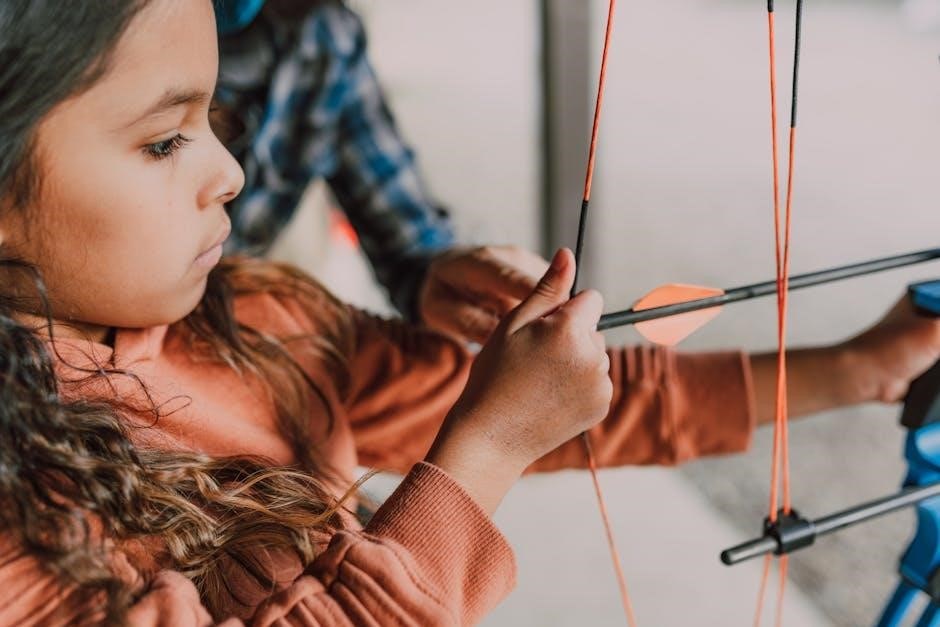Puberty marks a significant transition in a girl’s life, bringing about numerous physical and emotional changes. This guide aims to provide young girls with the knowledge to navigate this stage with confidence and understanding.
What is Puberty? Defining the Changes
Puberty is the period of life when a child’s body begins to develop and change into that of an adult. It’s a natural process driven by hormones, which are chemical messengers in the body. These hormones trigger a series of physical and emotional developments. For girls, puberty typically involves breast growth, the start of menstruation, and changes in body shape. It also includes hair growth in new areas, like underarms and the pubic region. Understanding these changes is key to embracing this new chapter. It’s a journey of self-discovery, preparing girls for adulthood with confidence and knowledge about their bodies.
The Start of Puberty
The commencement of puberty is a unique experience for every girl. Recognizing the signs and understanding the timeline can help navigate this transition smoothly, fostering self-assurance and positive body image.
Typical Age Range: 8-13 Years Old
Puberty typically commences for girls within the age range of 8 to 13 years old. It’s essential to remember that this is just an average, and every girl’s body develops at its own pace. Some girls may start puberty earlier, while others may begin later, and both are perfectly normal. Several factors can influence when puberty begins, including genetics, nutrition, and overall health.
Experiencing puberty outside this typical age range doesn’t automatically indicate a problem, but consulting with a healthcare professional can provide reassurance and address any concerns. Understanding this age range helps manage expectations.
Early Signs: Breast Bud Development
One of the earliest and most noticeable signs of puberty in girls is the development of breast buds. These appear as small, slightly raised bumps under the nipples. They might feel tender or sensitive to the touch. This initial stage of breast development indicates that the body is beginning to produce estrogen, the primary female sex hormone, which triggers many of the changes associated with puberty.
It’s important to note that breast bud development can occur at different ages for different girls, typically within the 8-13 age range. This is a natural and normal part of growing up, and there is nothing to fear.

Physical Changes During Puberty
Puberty brings about many physical changes for girls, including breast growth, hair growth, increased sweat, and the start of menstruation. These changes are all a normal part of development.
Breast Growth and Development
The development of breast buds is usually the first visible sign of puberty in girls, typically starting between the ages of 8 and 13. This process involves several stages, influenced by hormones, and leads to the full development of breasts over several years. The areola, the area around the nipple, also increases in size. It’s normal for breasts to grow at different rates, and they may not end up being exactly the same size. This growth is a natural and expected part of becoming a woman, so embrace the changes as they come.
Hair Growth: Pubic, Underarm, and Legs
As puberty progresses, you’ll notice hair growing in new places, primarily in the pubic area, underarms, and on your legs. Initially, the hair might be fine and sparse, but it will gradually become thicker and coarser over time. The amount and texture of hair can vary greatly from person to person, influenced by genetics and ethnicity. There’s no right or wrong way for hair to grow; it’s all part of your unique development. Remember, you have the freedom to decide how you want to manage this hair through shaving, waxing, or other methods.
Body Odor and Increased Sweat
During puberty, hormonal changes kick your sweat glands into higher gear, leading to increased sweating, especially in your underarms; This sweat, when mixed with bacteria on your skin, can cause body odor. Don’t worry, it’s a normal part of growing up! To manage body odor, daily showering or bathing with soap and water is essential. Using deodorant or antiperspirant can help reduce sweating and mask or prevent odor. Choose products that you like the scent of and that are gentle on your skin. Regular washing of clothes, especially those worn during physical activity, also helps control body odor.

Menstruation: Understanding Periods
Menstruation, or periods, is a key part of puberty for girls. Understanding what periods are, why they happen, and how to manage them is essential for every girl’s health and well-being.
What is a Period and Why it Happens
A period, also known as menstruation, is a normal part of the menstrual cycle that occurs in females, typically starting during puberty. It involves the monthly shedding of the lining of the uterus, resulting in vaginal bleeding. This process happens because the body is preparing for a potential pregnancy each month.
If pregnancy doesn’t occur, the uterine lining is no longer needed and is shed. The menstrual cycle is regulated by hormones and usually lasts about 21 to 35 days. Understanding this process is crucial for girls as they navigate puberty and their changing bodies, promoting body positivity.
First Period: What to Expect
Getting your first period, or menarche, is a significant milestone in puberty. It usually occurs between the ages of 8 and 16, but everyone’s body clock is different. It’s important to remember there’s no ‘right’ time. The flow can be light or heavy and last from 2 to 7 days.
You might experience cramps, bloating, or mood swings. Having pads, tampons, or menstrual cups ready is a good idea. Talk to a trusted adult, like a parent, guardian, or school nurse, if you have any concerns or questions. Remember, your first period is a normal and natural part of growing up, so celebrate this new chapter!
Menstrual Hygiene: Pads, Tampons, and Cups
Maintaining good hygiene during your period is crucial for comfort and health. Pads are absorbent materials worn inside underwear and need regular changing. Tampons are inserted into the vagina to absorb menstrual flow and require changing every few hours. Menstrual cups are reusable, flexible cups inserted into the vagina to collect blood; they’re emptied and cleaned.
Choosing between pads, tampons, and cups is a personal decision. Consider absorbency needs, comfort levels, and environmental impact. Always wash your hands before and after changing menstrual products. Regular showering and gentle cleansing of the vaginal area help prevent odor and infection. Practicing good menstrual hygiene promotes confidence and well-being.

Emotional and Mental Changes
Puberty brings emotional ups and downs. Understanding these changes is key. Recognize mood swings and increased sensitivity. Embrace self-care and seek support from trusted adults. Focus on building a positive body image.
Mood Swings and Emotional Sensitivity
During puberty, fluctuating hormones can lead to noticeable mood swings. You might feel happy one moment and easily irritated the next. Emotional sensitivity increases, making you more reactive to situations. Recognize that these feelings are normal and temporary.
Practice self-compassion and allow yourself to feel your emotions without judgment. Communicate your feelings to trusted friends, family, or mentors. Engage in activities that promote emotional well-being, such as exercise, creative expression, or mindfulness. Remember, seeking support is a sign of strength.
Understanding and accepting these emotional shifts can help you navigate puberty with greater resilience and self-awareness. It is crucial to remember these changes are perfectly normal.
Body Image and Self-Esteem
Puberty brings significant changes to your body, which can impact your body image and self-esteem. It’s normal to feel self-conscious or compare yourself to others. Remember that everyone experiences puberty differently, and there’s no “right” way to look.
Focus on appreciating your body for what it can do, rather than solely on its appearance. Challenge negative thoughts and replace them with positive affirmations. Surround yourself with supportive people who value you for who you are, not what you look like.
Engage in activities that make you feel good about yourself, whether it’s playing sports, pursuing hobbies, or spending time with loved ones. Prioritize self-care and remember that true beauty comes from within. Be kind to yourself.

Hygiene and Self-Care During Puberty
Puberty brings changes that require new hygiene habits. Prioritizing personal hygiene and self-care is crucial for feeling confident and healthy. These practices can help you manage changes and boost your well-being.
Importance of Personal Hygiene
Maintaining personal hygiene becomes especially important during puberty due to increased sweat and oil production. Regular showering or bathing helps to keep the skin clean and reduce body odor. Washing your face twice daily can prevent acne breakouts. Pay close attention to areas like underarms and the genital area, which require extra care.
Changing underwear daily is essential for freshness and preventing infections. During menstruation, frequent changing of pads, tampons, or menstrual cups is crucial for hygiene and comfort. Good hygiene habits contribute significantly to overall health and self-esteem. Establishing these routines early on can make a big difference.
Skincare: Dealing with Acne
Acne is a common concern during puberty due to hormonal changes increasing oil production. Establishing a consistent skincare routine can help manage breakouts. Washing your face twice a day with a gentle cleanser removes excess oil and dirt. Avoid harsh scrubbing, which can irritate the skin.
Over-the-counter acne treatments containing benzoyl peroxide or salicylic acid can be effective. Spot treat blemishes as needed. Moisturizing is also crucial, even for oily skin; choose a non-comedogenic moisturizer. Avoid picking or squeezing pimples, as this can lead to scarring. If acne is severe, consult a dermatologist for personalized treatment options and advice. A healthy diet and hydration also support clear skin.

No Responses